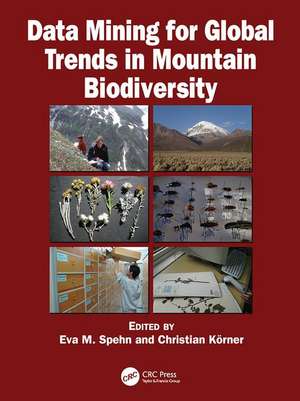Data Mining for Global Trends in Mountain Biodiversity
Editat de Eva M. Spehn, Christian Korneren Limba Engleză Paperback – 21 iun 2017
Expert contributors address two aspects of the Global Mountain Biodiversity Assessment. They cover how to link biodiversity data with geophysical data and how to use biodiversity data to substantiate evolutionary and ecological theory. The text provides different methodological approaches and examples of successful mining of geo-referenced data in mountain regions on various scales. It includes:
- Elevational and latitudinal gradients in plant diversity
- E-mining trends in diversity of Lepidoptera, beetles, and birds
- Niche modeling to explain past trends and predict future trends in mountain biodiversity
- Sharing biodiversity data with the Global Biodiversity Information Facility
Preț: 426.17 lei
Preț vechi: 574.25 lei
-26% Nou
Puncte Express: 639
Preț estimativ în valută:
81.56€ • 84.83$ • 67.33£
81.56€ • 84.83$ • 67.33£
Carte tipărită la comandă
Livrare economică 14-28 aprilie
Preluare comenzi: 021 569.72.76
Specificații
ISBN-13: 9781138112636
ISBN-10: 1138112631
Pagini: 194
Ilustrații: 63
Dimensiuni: 191 x 254 mm
Greutate: 0.36 kg
Ediția:1
Editura: CRC Press
Colecția CRC Press
ISBN-10: 1138112631
Pagini: 194
Ilustrații: 63
Dimensiuni: 191 x 254 mm
Greutate: 0.36 kg
Ediția:1
Editura: CRC Press
Colecția CRC Press
Public țintă
ProfessionalCuprins
Exploring and Explaining Mountain Biodiversity: The Role and Power of Geophysical Information Systems. Primary Biodiversity Data—The Foundation for Understanding Global Mountain Biodiversity. Using Primary Biodiversity Data in Mountain Species Numbers Assessments. The Global Need for, and Appreciation of, High-Quality Metadata in Biodiversity Database Work. A Possible Correlation between the Altitudinal and Latitudinal Ranges of Species in the High Elevation Flora of the Andes. Exploring Patterns of Plant Diversity in China’s Mountains. Elevational Pattern of Seed Plant Species Richness in the Hengduan Mountains, Southwest China: Area and Climate. Elevational Gradients of Species Richness Derived from Local Field Surveys versus “Mining” of Archive Data. Species Richness of Breeding Birds along the Altitudinal Gradient—An Analysis of Atlas Databases from Switzerland and Catalonia (NE Spain). Diverse Elevational Diversity Gradients in Great Smoky Mountains National Park. Integrating Data across Biodiversity Levels: The Project IntraBioDiv. A Plant Functional Traits Database for the Alps—Application to the Understanding of Functional Effects of Changed Grassland Management. Using Species Occurrence Databases to Determine Niche Dynamics of Montane and Lowland Species since the Last Glacial Maximum. A Georeferenced Biodiversity Databank for Evaluating the Impact of Climate Change in Southern Italy Mountains. Using Georeferenced Databases to Assess the Effect of Climate Change on Alpine Plant Species and Diversity. The “Mountain Laboratory” of Nature— Largely Unexplored Mine of Information: Synthesis of the Book. Creative Use of Mountain Biodiversity Databases: The Kazbegi Research Agenda of GMBA-DIVERSITAS. Index.
Recenzii
"Overall, the book provides a rich resource of valuable information and stimulation for those who are willing to dig into the detail of the individual chapters, As a whole, it demonstrates well how data mining techniques ran complement, but not necessarily replace, expensive experiments, thus furthering ecological and evolutionary theory."
-- Spehn. Mountain Research and Development (MRD). August 2010, Vol 30, No. 3
-- Spehn. Mountain Research and Development (MRD). August 2010, Vol 30, No. 3
Descriere
Thanks to advances in electronic archiving of biodiversity data and the digitization of climate and other geophysical data, a new era in biogeography, functional ecology, and evolutionary ecology has begun. In this book Christian Korner, Eva M. Spehn, and a team of experts from the Global Mountain Biodiversity Assessment of DIVERSITAS explore two of the hottest subjects in science and technology: biodiversity and data mining. They demonstrate how to harness the scientific power of biological databases for furthering ecological and evolutionary theory. The text provides different methodological approaches and examples of successful mining of geo-referenced data in mountain regions on various scales.






